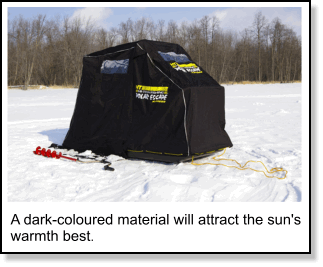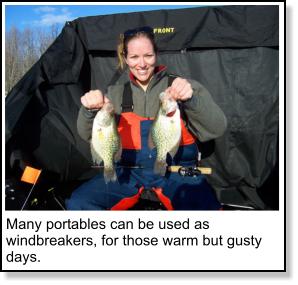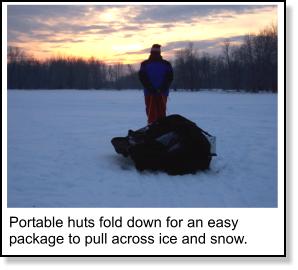The bitter wind blew furiously, pelting me with
unforgiving force, while sapping my warmth and enthusiasm. I
struggled to clench my ultra light rod, my grip loosening as my
glove raised a white flag to the invisible enemy we all call
cold.
Then, the snow started to fall. Not tranquil
flakes Norman Rockwell might depict, but the ferocious,
mean-spirited kind that only the Grinch could conjure up to spoil a
deserving child's Christmas.
 I was sitting on frozen Big
Rideau Lake, near Ottawa Ontario, and beginning to hate ice
fishing. My friend was parked a mere 20 feet away, cozy and
content in his one man portable hut, oblivious to the elements
outside. To make matters worse, I could hear regular plopping sounds
coming from his hut, as he tossed chunky crappie into a half-filled
bucket of water. I, on the other hand, had one frozen crappie
laying at my frostbitten feet, a snowbank of white stuff steadily
covering my lack of fishing success.
I was sitting on frozen Big
Rideau Lake, near Ottawa Ontario, and beginning to hate ice
fishing. My friend was parked a mere 20 feet away, cozy and
content in his one man portable hut, oblivious to the elements
outside. To make matters worse, I could hear regular plopping sounds
coming from his hut, as he tossed chunky crappie into a half-filled
bucket of water. I, on the other hand, had one frozen crappie
laying at my frostbitten feet, a snowbank of white stuff steadily
covering my lack of fishing success.
On that day I vowed
never to hit the ice without a portable hut in tow.
The
modern portable
ice fishing hut is the greatest invention to be
bestowed on the ice-fishing fraternity since the power auger.
Gone are days of cold feet and hands, blowing and ice-covered line,
and aborted outings due to unbearable weather.
Choosing a portable can be tough task for the newbie, but
narrowing down the choices will lead you to the perfect home away
from home.
Why Choose a Portable?
Modern
portables are simple and practical. Gear can be stored and
loaded effortlessly, allowing easy transportation to and from the
ice, all in a package that can be pulled by hand or
snowmachine. Windows, doors and seating structures offer most
of the luxuries that a wooden hut would have, without having to
remain in one spot.
Portables allow unparalleled mobility,
with a quick "fold down and trudge on" mentality by the owners,
which cannot be found with anglers in stationary varieties.
Portables are becoming more affordable, and with a wider
variety available with each passing season, it's no wonder that more
and more anglers are recognizing their benefits.
A
Material Matter
Portable huts are manufactured from a
wide range of materials, but mainly nylon, canvas, or
poly-cotton. For the most part, the type of material is less
of an issue than its strength and thickness, as these separate the
good from the mediocre in terms of performance.
Choose a hut
with the thickest, toughest material you can afford. A strong,
tear resistant outer shell prolongs the life of a portable, while
also keeping the warmth intact. Making sure the material is
breathable also goes a long way towards ultimate comfort by cutting
down on condensation buildup. A water-resistant material is
also the way to go for obvious reasons, as is making sure it is fire
retardant.
Try to buy a dark material that will absorb the
sun's warmth, cutting down on heating costs.
Sizing
Up the Competition
For solitary anglers, a one-man hut
is sufficient. They're small and light, easy to transport, and
heat up and hold warmth well. Many companies offer a variety
of sizes in one-man huts, so check around to see which one suits
your needs, budget, and body size.
If you carry a lot of gear or
prefer more room to stretch out, a two-man portable would be
better. It also gives you the option of offering a chair to a
fishing buddy that might want to tag along. Moving up a size
increases purchase cost, but the extra space is worth the
investment.
When dealing with extended families or
numerous angling comrades, look at four- or six-man cabins or
systems that can be used to connect two smaller huts.
With
added size comes weight, though, and pulling a king-of-the-hill hut
requires a snow machine - and, you'll likely need a truck, trailer
or roof racks to transport it to the ice.
Setting It
Up
There are two main types of huts on the market -
fold-over and tent style. A fold-over simply pulls over the
top of you in one fluid motion. They're slick and the fastest
style available.
Folding tent styles are usually box shaped and
incorporate aluminum or alloy poles that are hinged or snapped
together to form the inner frame. They take longer to put up,
but are still great buys, as long as the process isn't overly
complicated or time-consuming.
Test a few styles at the shop and
pick the one you feel most comfortable with. Just remember, it
will become your second home for a few months each year, so choose
wisely.
Take a Seat
 Portable-hut seating
options include providing your own or relaxing in a built-in
version. Most flip-style huts have a self-contained seat,
while tent varieties are more prone to be without one.
Built-in seats should be strong, durable, and, most of all,
comfortable. A padded topside comes in handy during long hours
on the ice. Many styles offer built-in tackle trays and cups
and rod holders, other useful additions.
Portable-hut seating
options include providing your own or relaxing in a built-in
version. Most flip-style huts have a self-contained seat,
while tent varieties are more prone to be without one.
Built-in seats should be strong, durable, and, most of all,
comfortable. A padded topside comes in handy during long hours
on the ice. Many styles offer built-in tackle trays and cups
and rod holders, other useful additions.
The drawback to using
your own chair is having to lug it out on the ice. It can be
strapped down to the hut when towing, but this is less convenient
than having a built-in one. That being said, bringing your own
chair gives the freedom to place it in any position you desire,
something that's not always possible with a built-in
one.
Peering Out
Windows are pretty much
standard in today's portable huts. Without them, watching
tip-ups, checking on the weather, and seeing what's happening around
you would be all but impossible. The larger the windows, the
better. For shallow water sight fishing, however, you will
want the option of darkening the hut to let you see better in the
water below. So, make sure windows have covers.
Many first-time hut buyers overlook that windows should be
positioned at the appropriate height for them. Depending on
your posture in the seat and on your body height, windows can be
either too low or too high for viewing purposes. Try a
potential hut with the chair you intend to use it with. If
you're not seeing eye to eye with the windows, then the model isn't
right for you.
Heating Up the Inside
In order
to keep warm in your hut, a portable propane heater is a
necessity. There are several styles, with the new breed of
catalytic heaters being the safest on the market, offering
flame-free heat and approval for inside use. Run off small
propane canisters, they can keep you toasty warm when the
temperatures outside is frigid. For most portables, 3,000 BTUs
is the bare minimum needed. Look for heaters offering up to
9,000 BTUs for larger portables. I've used a Mr. Heater
"Portable Buddy" for many years now, and find that the option to
switch from 4,000 to 9,000 BTUs is optimum for both my one and
two-man hut.
 A Towing We Will Go
A Towing We Will Go
To haul
your portable across the ice, the two main options are to use brute
strength or pull it behind a snow machine. In either case, a
built-in sled on the bottom of your hut is needed.
Most
portables on the market fold down into compact sleds molded out of
polyethylene. The sled can hold all essentials needed for a
day on the ice - including bait buckets, rods, auger, and sonar -
and allows for easy transport over snow and ice. Make sure the
sled you have is strong and durable to take any punishment you may
give it.
Hand-tow ropes should be thick and with enough
length so that the sled isn't nipping at your heels. Make sure
ropes are easy on the hands, as you'll be spending a significant
amount of time pulling the hut to and fro.
Bottom
runners should be large, with smooth edges, allowing for easy
towing. A sled with a tapered front rides over snow more
easily, something your muscles or snow machine will thank you for.
Good luck on buying a portable hut that's perfect for your
needs. Getting set up with one can lead you on new and
exciting adventures. Not only will your success rate increase,
but also your comfort level. Enjoy the thrill of owning a home
away from home - and make your own "Rideau" story a tale from the
past too.